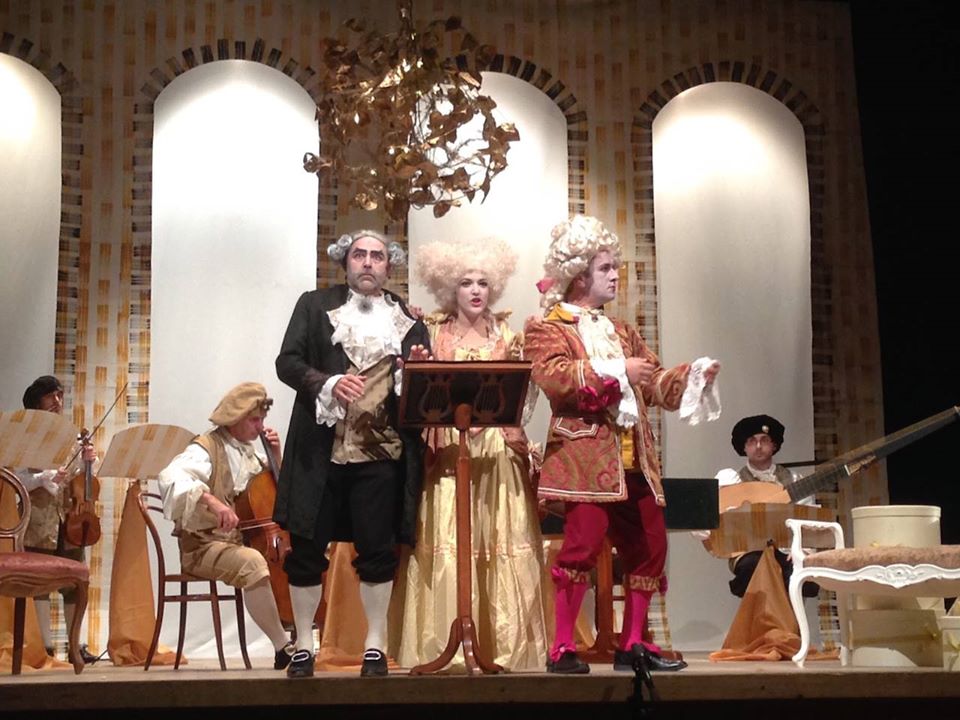TEATRO TORTI - BEVAGNAThe feature that makes the Teatri Torti unique is that it is housed in the medieval Palazzo dei Consoli, which dominates the central square of Bevagna. Climbing a large outside staircase and going through the rough wooden door forming part of the gothic façade you take a leap forward of 600 years and enter the gilded world of the fin de siècle with exquisite frescoes, velvet chairs and curtains and, again unique, galleries of cast iron. The Palazzo dei Consoli was for centuries the centre of power of the city and, after being abandoned for some time when Bevagna was hit by an earthquake, it was transformed by a group of entrepreneurial citizens in a place of culture in 1887.
La caratteristica che rende il Teatro Torti unico è che è incastonato nel Palazzo medievale dei Consoli che domina la piazza centrale di Bevagna. Salendo una larga scalinata esterna, e entrando attraverso le porte di legno della facciata gotica, si fa un salto avanti di 600 anni e si entra nel mondo dorato della fin de siècle con delicati affreschi e poltrone di velluto e drappi, e ancora una volta unica la galleria di ghisa. Il Palazzo dei Consoli è stato per secoli il centro di potere della città e, dopo essere stato abbandonato per qualche tempo a causa di un terremoto, fu trasformato da un gruppo di imprenditori in un luogo di cultura nel 1887. |
Per tutte le fonti iconografiche presenti in questo sito si ringraziano il Comune di Bevagna e, in particolare, Marta Gaburri per l'opera "Il teatro di Bevagna", Ed.EFFE 2000. |
TEATRO SOCIALE - AMELIA
|
One of the most beautiful theatre that can be found in Italy. When you enter you are struck by the beauty of the furnishings and the magic that the theatre gives off.
The Teatro Sociale of Amelia, one of the first theatres of the eighteenth century, was born from the will of some noble friends whose desire was that the theatre would be open to everybody. Inaugurated in 1783, it is one of the few examples of eighteenth-century theatres built entirely of wood, from the structures to the stage machines that are still functioning. In the nineteenth century the orchestral pit was created and the proscenium boxes were added. The decorations we see date back to the late nineteenth century and are the work of Domenico Bruschi, together with the painted canvas that represents the legendary siege of Amelia by Federico Barbarossa's troops. This theatre was a big surprise and discovery for us during the Adopt a Theatre project of OperaExtravaganza. To revive the Teatro Sociale of Amelia OperaExtravaganza has performed several opera productions in this jewel of an Italian theater from the Dirindina by Domenica Scarlatti to the Magic Flute by W.A.Mozart. The ghost of Amelia's Theatre "There is Angelino, the friendly ghost who quietly runs between one stage and the other parts of the theatre." The gost has been named Angelino by the keeper of the theater who always has a lot to do: when the ghost turns on the lights he turns them off, and when he turns them off, of course, the friendly spirit turns them on again. But it is not limited to this; the legend, in fact, tells that Angelino fears the public, which is why he disappears at every show. But he is not afraid of the artists, on the contrary he loves to see them rehearsing and he seems to follow them secretly in the darkness of the theatre. Scenes of many films and screenplays were filmed in this splendid theater, including scenes from Pinocchio with Nino Manfredi and the Marchese del Grillo with Alberto Sordi. Uno dei teatri più belli che si possono trovare in Italia. Quando si entra si viene colpiti dalla bellezza degli arredi e dalla magia che la sala emana. Il teatro Sociale di Amelia, uno dei primi teatri del 700, nato dalla volontà di alcuni amici nobili il cui desiderio era che il teatro fosse aperto a tutti Inaugurato nel 1783 è uno dei pochi esempi di teatro settecentesco costruito interamente in legno, dalle strutture alle macchine sceniche che sono ancora funzionanti, che sia arrivato fino a noi. Nell'ottocento si è creata la fossa orchestrale e furono aggiunti i palchi di proscenio. I decori che vediamo risalgono alla fine dell'ottocento e sono opera di Domenico Bruschi, unitamente al telone dipinto che rappresenta il leggendario assedio di Amelia da parte delle truppe di Federico Barbarossa. E' stata la grande sorpresa durante il nostro progetto di Adotta un Teatro Storico. Per fare rivivere il Teatro Sociale di Amelia OperaExtravaganza ha portato più’ produzioni in questo gioiello di teatro all’italiana dalla Dirindina di Domenica Scarlatti al Flauto Magico di W.A.Mozart. Il fantasma del teatro sociale di Amelia „C'è Angelino, il simpatico fantasma che scorrazza tranquillo tra un palchetto e l’altro.“ È stato ribattezzato Angelino dal custode del teatro che ha sempre un gran da fare: quando accende le luci il fantasma le rispegne e quando le spegne, ovviamente, il simpatico spirito le riaccende. Ma non si limita a questo; la leggenda, infatti, narra che Angelino tema il pubblico, ragion per cui si dilegua a ogni spettacolo. Ma non ha paura degli artisti, anzi ama vederli provare e sembra che li segua di nascosto nell'oscurità della platea e tra i palchetti. In questo splendido Teatro sono stati girate scene di molti films e sceneggiati, tra cui scene anche del Pinocchio con Nino Manfredi e del Marchese del Grillo con Alberto Sordi. |
Copyright © 2020 OperaExtravaganza. All Rights Reserved












